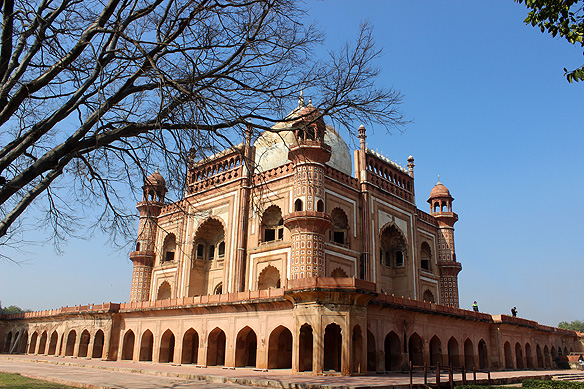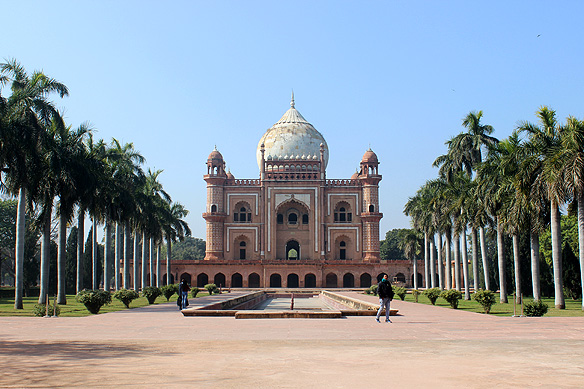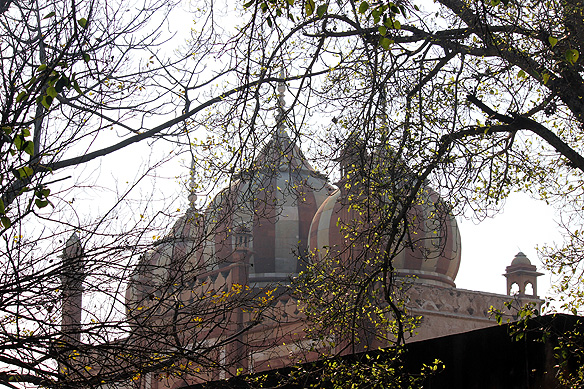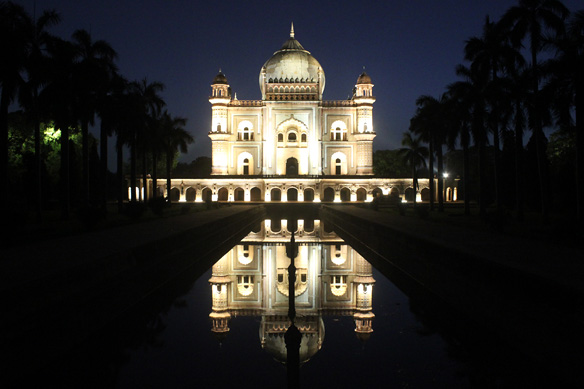
Another tomb!
I’d once read that in London, at the turn of the 20th Century when the British Raj was planning to move its capital from Calcutta to Delhi, a British newspaper had called Delhi the ‘graveyard of dynasties’.
It was in reference to the countless tombs of the Muslim dynasties and their key officials, first those of the Delhi Sultanate and then the Mughal Empire, who had ruled Delhi for 660 years. These tombs dot every nook and corner of the city. Some are grand and ostentatious. Some humble and tiny. But they are everywhere.
Many have crumbled over time and been replaced with the fast-burgeoning, steel and concrete ‘New Delhi’. I wonder how many there would have been, say a hundred years ago, or at the closing chapter of the Mughals in 1857, as I gasped in awe at the ceiling inside.
Where was I? In a tomb.
But of such incredible grandeur that it took my breath away. And it did not even belong to a ‘ruler’ or built at the zenith of an empire. It was for just one person, the Wazir or Prime Minister, when the Mughal empire was slowly but surely fading away. 1754 AD.
Such flamboyant displays of wealth and power seemed to be the order of the day.

The tomb was built for the second Nawab of Awadh, a rich and powerful Persian gentleman better known by the name Safdarjung, and has an interesting story to its credit. Safdarjung’s full name, by the way, was Abul Mansur Mirza Muhammad Muqim Ali Khan.
He was an ambitious gentleman and soon found his way to the post of Wazir or Prime Minister in the Mughal court in 1748. He was also, uhm, slightly overambitious and made the emperor’s life miserable by usurping powers. If that were not enough, he had the Emperor’s mother’s [Qudsia Begum’s] paramour [an eunuch called Jawed Khan] murdered thinking it would win him brownie points. Things did not go as planned and he was driven out instead in 1753; he died the next year.
When his son, Shujaud Daula became Wazir, he pleaded with the emperor to forgive his father and allow him to be buried in Delhi. On being granted his request, he built this grandiose affair designed by an Abyssinian [Ethiopian] architect to house Safdarjung’s grave. But money was scarce, so the son stripped another tomb [that of Abdur Rahim Khan-i-Khanan] of its building material, to decorate his dad’s.
What’s also interesting is the location. Safdarjung Tomb is away from the usual Mughal burial areas. Reason being Safdarjung was a Shi’a Muslim and there’s a Shi’a dargah, Shah-e-Mardan, in the vicinity. The Mughals were Sunnis.
Stories. Such stories these stones do tell.


AT DAY …
Whilst my mind rewound what I’d read, my heart literally sang at the detailed incised plasterwork which turned the ceilings into veritable works of art in the last monumental tomb garden built in the Mughal-era.
I also noticed a number of features which set it apart from other tombs. The elongated height of the tomb which made it look disproportionate, the five-part facades with Shahjahani cusped arches and attached minarets, and the three-domed wistful mosque. And there were the usual suspects such as the char bagh garden edged with pavilions christened, in this case, Moti Mahal [pearl palace], Jangli Mahal (forest palace), and Badshah Pasand (King’s favourite). They were, apparently, used by Safdarjung’s family and relatives when they visited his tomb. His wife lies interred next to him in the vast, otherwise empty crypt.
Not many people visit Safdarjung’s tomb. The entrance gate, although grand and decorated profusely with painted muqarnas, gives no clue to what treasures lie inside. Outside, the heavy, constantly streaming traffic leaves little opportunity to venture in. But look what I found inside was all I could marvel at. Definitely, not just another tomb! 😊

The glorious ceiling in the main burial chamber. A cloud burst of kinds!

Safdarjung’s solitary gravestone lies in the central chamber surrounded with eight rooms in the hasht-behisht floor plan, a re-creation of the eight gates of paradise in Islam.

Built with red sandstone and marble ‘stolen’ from another tomb, the only original expensive piece of embellishment in Safdarjung Tomb is a strip of pietra dura at the entrance of the main chamber. Right: The fairytale-like mosque in the complex is unfortunately closed to the public.

I loved this viewpoint. From this angle, the tomb reminded me so much of Humayun’s Tomb and even the Taj Mahal.


Elaborate restored muqarnas, painted in natural colours, fill the deep arches of the tomb’s entrance gateway. The image above is a zoomed-in detail.

Safdarjung Tomb’s mosque veiled by nature.
AND AT NIGHT …
Come dusk, Safdarjung Tomb, along with Humayun’s Tomb, Red Fort, and Qutab Minar fall under the ambit of Delhi’s night tourism initiative. What this means is that the sites get lit up and transform into a magical world of golden dappled monuments floating in darkness. I had heard much of it, seen many photographs, but not been to any yet, that is not at night.
Now at Safdarjung Tomb, I was determined to experience it, first hand.
Camera in hand, I seated myself in front of the tomb and clicked away as the minutes passed. The balmy Indian summer day gave way to the long lazy shadows of the afternoon sun which in turn led to a musky lavender dusk. The lights got turned on and started to cast their softness on the stone. Purple skies, waiting in the wings, followed, to be a backdrop for a, by now, flaming Safdarjung Tomb reflected equally magnificently in the waterway. Just when I thought it couldn’t get more spectacular, the night sky went pitch black [it was a moonless night] and the tomb, and its reflection, both shimmered in bright silver light.
Magic.
Mosquitoes, busy biting my arms and whirling over my head, brought me back to earth—with big red bumps. It was time for me go. Goodbye, Safdarjung Tomb. It was lovely meeting you.
PS. I am not going to caption the below images, but will let them speak for themselves … ❤





Travel tips:
- The night lighting is switched on at 6:30 pm.
- After 6:30 pm, one cannot walk through the monument; it can only be viewed from the front end of the waterway.
- My visit comprised of an independent exploration followed with a guided heritage walk by Intach Delhi.


I’m so glad you visited Safdarjung’s tomb. It’s so often overlooked by people heading to Red fort and Qutub minar. I pass it every day on my way to work and marvel at it’s beauty.
Did you get a chance to visit the Mehrauli archaeological park?
LikeLiked by 1 person
Safdarjung Tomb is an absolute treasure. I explored it twice and both times I was completely bowled over. And, yes, I did get to explore Mehrauli Archaelogical Park too. Another very less visited and wonderful site. Delhi is a heritage buff’s paradise. 🙂
LikeLiked by 1 person
What a beautiful building, and I’m glad you stayed to take those evening and night pictures, gorgeous! Maggie
LikeLiked by 1 person
Thanks Maggie. Covid has forced me to become a travel opportunist. 🙂 The tomb is spectacular, but at night, with all the lighting, it just becomes extra magical.
LikeLiked by 1 person
Magical sunset series at Safdarjung Tomb!
LikeLiked by 1 person
Thank you. 🙂 It was the first time I was seeing Delhi’s monuments all lit up at night. I am so glad I chose Safdarjung’s tomb as the firstest.
LikeLike
I often find less visited places equally impressive as their more famous counterparts, and that sounds like what you experienced at Safdarjung’s tomb. While the structure already looks beautiful and magnificent from the outside, its interior is no less interesting. I’m particularly captivated by the decoration of the ceiling in the main burial chamber. It does appear to be a burst of clouds! And despite the mosquitoes, I’m glad you decided to stay to take photos of the tomb at dusk.
LikeLiked by 1 person
I agree with you that often, less visited places are equally impressive. At Safdarjung’s tomb, the incised plaster-work has to be some of the finest I have ever seen. Many historians and art critics have, unfortunately, criticized the tomb for its disproportionate structure [in comparison to the Taj Mahal] and poor quality of building material leading to its fall in popularity ratings. But, then ‘perfection’ is subjective. I loved the tomb, just the way it was. 🙂
LikeLiked by 1 person
We don’t always have to agree with critics. 🙂 In the end, the arts are deeply subjective.
LikeLiked by 1 person
So true. 🙂
LikeLiked by 1 person
A lovely account of this beautiful monument which gets a raw deal of sorts by people living in Delhi. It gets passed by. Incidentally, I was your Intach co-walker that day and realize, looking at your pictures, how effectively photos freeze moments of fleeting pleasurable sensations/experiences. Artwork on ceiling and deep arches of entrance is indeed stunning. Also, I felt a strange uniqueness in the way this rather smallish monument sits in the relatively vast expanse of garden around it.
Thank you.
Santosh
LikeLiked by 1 person
Welcome to my blog, Santosh. So happy to meet you again here. 🙂 Safdarjung Tomb is a pure gem, and a part of me is actually glad it gets passed by. The crowds are less. The selfie-takers and instagrammers almost nil. What remains is a beautiful, wistful monument to be enjoyed and experienced by those who take the trouble to explore its charms. I hope you enjoy my other posts on Delhi too. Coming up is the night walk in Chandni Chowk! I publish new posts on Mondays at 10 am.
LikeLiked by 1 person
Glad to be here myself. And agree with you completely what you have said above about the monument.
Look forward to your next. However I had to leave everything aside and go to your Durban blog. Reason explained there 🙂
LikeLiked by 1 person
Hi, great write-up! Looking to definitely visit some of the Delhi monuments at night during my upcoming visit in Jan 2023. Wha would be the best way to book – would that be through ASI website?
Cant seem to find any reliable info or heritage walk schedules or contacts to plan through INTACH – any inputs will be super helpful…
LikeLiked by 1 person
Hello Brunda. Thank you for stopping by. The monuments are stunning at night. Am sure you’ll enjoy them. 🙂 Most walk setups, including Intach, unfortunately, do not have a schedule. Walks are announced a few days in advance on their social media handles, i.e. Instagram and Facebook. Some do offer private tours but they are comparatively expensive. I’d suggest you keep an eye on their social media handles whilst here and go for those that pick your fancy. For those not on offer, explore on your own, based on some reading. I have written a lot on Delhi — please have a look at the Delhi section under Exploring India. Hopefully it will help.
The ASI site is for buying the entry tickets. Good idea to buy them beforehand. Saves time. Happy travels!
LikeLike
Thank you! Your blog is very informative and certainly projects your passion to explore, keep going!
LikeLiked by 1 person
Thank you. 🙂 Please feel free to reach out if you need any further info.
LikeLike